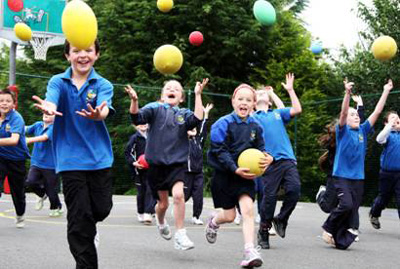With the seemingly endless push towards a rigorously academic curriculum that emphasizes subjects such as reading, writing and math, physical education may get left behind.
That said, the National Association for Sport and Physical Education notes that P.E. classes can help kids to increase self-discipline, improve self-confidence and reduce stress. Additionally, the core motor skills that your child can develop through P.E. classes work to improve her flexibility, build coordination and help her to participate in other physical types of activities.
Standards
National and state learning standards aren’t just for subjects such as mathematics or the sciences. Physical education teachers also base their class curricula on standards that organizations such as the National Organization for Sport and Physical Education sets. The predominant goal of P.E. standards is to build fundamental motor skills and increase physical activities. The NAPSE national standards for students in kindergarten through grade 12 include exhibiting the ability to use an array of motor skills and different patterns of movement, applying knowledge of movement concepts to the physical activities, maintaining a health-enhancing level of fitness, respecting peers and showing responsible behaviors during physical and motor activities and understanding the value that physical activity has when it comes to health, social situations and self-expression.
Early Childhood
From toddler age through the beginning of grade school, kids in the early childhood period are developing the most basic motor skills through physical education opportunities. Your young child is learning how to walk and run as a toddler and as he grows, is refining these and other motor skills, such as throwing, catching, hopping, skipping, balancing and climbing. The research-based HighScope preschool curriculum includes a physical development and health component that promotes goals for the young child’s gross motor skills such as demonstrating flexibility, strength and balance. Additionally, your young child will enhance his body awareness, or understanding of where he is and how he’s moving in relation to other people and objects, through basic physical education course content.
Grade School Children
As your child moves into the middle and later years of grade school, you may begin to see a substantial difference in her gross motor abilities and an increased interest in participating in sports. Physical education at this stage serves to further develop your child’s basic skills, encourage positive social interactions with peers and help her to understand why exercise and fitness are key to a healthy lifestyle. For example, your third grader’s P.E. teacher may set fundamental goals that include manipulating objects through her movements, such as dribbling a basketball or catching a baseball, while your fifth grader’s teacher may expect her to demonstrate more complex movements such as throwing a ball at different height levels.
Tweens and Teens
Your tween or teenage child is growing more mature in his use of large motor skills, and may have the ability to play sports or engage in other physical activities at or above an adult level. During adolescence, the physical education focus is often on skills that children in this stage are ready to build such as gaining speed, improving jumping height and strength and developing endurance. Additionally, the Centers for Disease Control and Prevention notes that participating in P.E. classes can also help teens to develop the positive attitudes about fitness that are important to carry on a lifelong enjoyment for and engagement in exercise and physical activity.

